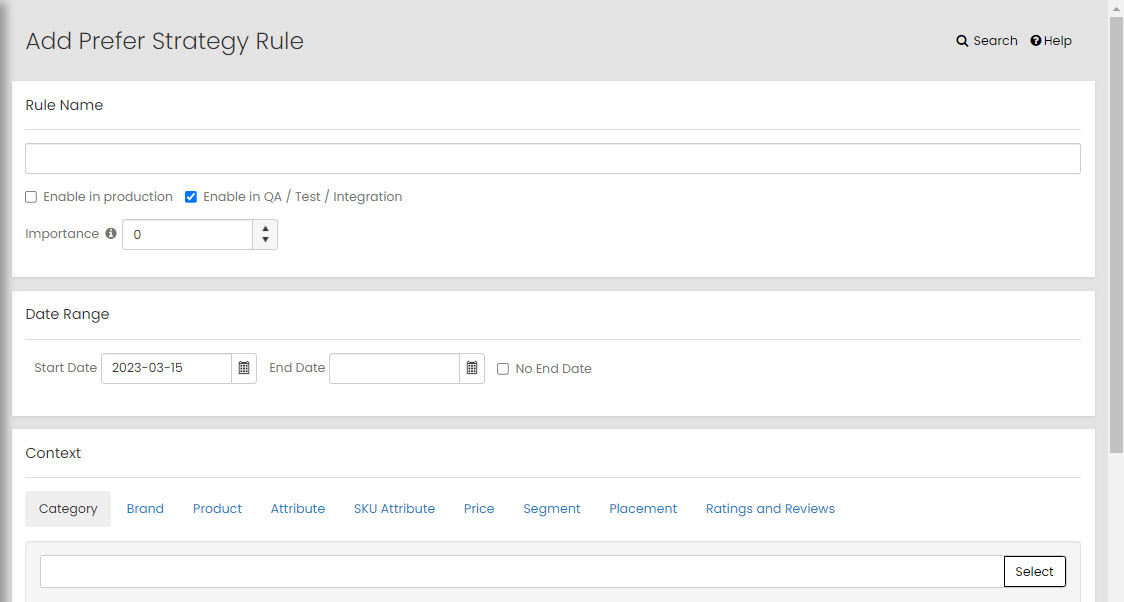Creating Rules for Preferred Strategies
Overview
The Strategy Rules in Omnichannel Personalization enable the selection of strategies to be used in a specified context. These rules will override the optimization system (Über) and always show specified recommendation strategies in the context and/or placement.
Creating Rules
For rules to work, you MUST designate a strategy message in the Strategies Configuration page. If the strategy used in a rule has no strategy message, the strategy will not qualify for display.
The rules created here will override disabled strategies in the Strategies Configuration page This means that if you have disabled a strategy in the Strategies Configuration page, and then create a rule to prefer it, the rule will take precedence and the disabled strategy can be used.
The strategy rule workflow is similar to creating merchandising rules.
-
On the Omnichannel Personalization dashboard, go to Recommendations > Strategy Rules.
The Strategy Rules page is displayed.

-
Click Add Rule. The Add Prefer Strategy Rule page is displayed.

-
Specify Rule Name.
-
Select the following to enable the rule in Production or QA environment:
-
Select the Enable in production checkbox to enable the rule in production environment.
-
Select the Enable in QA / Test / Integration checkbox to enable the rule in QA/Test/Integration environment.
-
-
Specify the rule's "Importance." If there are conflicting rules, the rule with the higher importance specified here will win. This is a numerical value (decimals can be used).

-
Specify Start Date and End Date. Select the No End Date checkbox for endless rule.

-
Specify Context. This defines "the where" on the site the rule will run.

-
Add the preferred strategies. The text field auto completes strategies.
-
(Optional) You can specify the order in which the strategies will run. For example, if you want to run a personalized strategy first (if you have enough data to personalize), and top sellers second, you may define the order in which our system attempts to use strategies.
-
(Optional) You can choose the following options available under Strategy:
-
Specify Order: Choose this option to specify the order in which the strategies should be executed. This step determines the sequence in which the system attempts to use the strategies.
-
Use only these: Choose to use only the strategies listed here. If selected, and the specified strategies cannot be executed, the system will not return any content for the placement. If this is left unchecked, the system will attempt to use preferred strategies first, and then fall back to any strategy enabled for the page.
-
Enable backfill: This option allows you to enable backfilling if the specified strategies cannot be executed. Enabling backfill ensures that some content is displayed even if the preferred strategies fail. Backfill is based on the minimum item count on the placement. If the first strategy selected meets the minimum item count, then the backfill will not be triggered. Backfill triggers when the initially selected strategy fails to meet the placement's minimum item count requirement.
For example, if the minimum item count is set to 5 and the maximum is set to 8, then if the first strategy returns 5 products, no backfill will be used. However, if the first strategy returns only 4 products, falling short of the minimum requirement, the backfill strategy will be triggered to ensure that the placement displays at least 5 products. It is recommended to set both the minimum and maximum item counts to the same value.

-
-
Click Save to save the rule.
Execution of Strategy Rules
Normally, recommendations are executed based on the ordering of the placements. The first placement called is the first recommendation executed on. However, when strategy rules are applied to a placement, the placement with a strategy rule takes priority in execution and is the first placement executed on.
Example:
First, the ordering is based on the order of placements put in the request parameters. Then, the order of placement is prioritized based on whether those placements have a strategy rule or not.
For this example, there are 4 placements in question:
|
item_page.rr_testing |
item_page.recs_1 |
item_page.recs_2 |
item_page.recs_3 |
In this case:
item_page.rr_testing does not have strategy rule
item_page.recs_1 is an invalid placement
item_page.recs_2 has strategy rule
item_page.recs_3 has strategy rule
Based on the strategy preference rules in place, the placements get re-ordered and executed on in this order:
item_page.recs_2
item_page.recs_3
item_page.rr_testing
This way the preferred strategies set in the strategy rules are executed first.
If the placements are instead listed in the following order, with the same rules in place:
|
item_page.rr_testing |
item_page.recs_1 |
item_page.recs_3 |
item_page.recs_2 |
Then the final order will be:
item_page.recs_3
item_page.recs_2
item_page.rr_testing